Analysis of the Impact of Stator Inter-Turn Short Circuits on PMSM Drive with Scalar and Vector Control
Abstract
:1. Introduction
2. Mathematical Model of the Permanent Magnet Synchronous Motor and Its Verification
2.1. Modeling of a Healthy PMSM
- -
- the stator winding is symmetrical, three-phase, with concentrated parameters,
- -
- resistance and inductance parameters are assumed to be constant,
- -
- magnetic circuits are linear, isotropic (saturation, eddy currents, and hysteresis are ignored),
- -
- the air gap of the machine is regular along the entire circumference,
- -
- only the fundamental harmonic of the field distribution in the air gap is taken into account,
- -
- a sinusoidal distribution of magnetic induction in the air gap is assumed,
- -
- no winding in the rotor due to the use of permanent magnets.
2.2. Modeling of the PMSM with Fault in the Stator Finding
2.3. Experimental Verification of the Simulation Model
3. Open and Closed-Loop Speed Control of PMSM—Structures and Modeling
3.1. Open-Loop Scalar Control of PMSM
3.2. Field Oriented Control of PMSM
4. Analysis of the Influence of Shorted Turns to the Operation of the PMSM Control Structures
4.1. Simulation Studies of the Control Structures of PMSM with Healthy Stator Winding
4.2. Analysis of the Impact of Inter-Turn Short-Circuits in the Stator Windings of the PMSM Motor on the Operation of Control Structures
5. Diagnostic Indicator for the Detection of Shorted Turns for PMSM of Open and Closed-Loop Control Structures
6. Conclusions
Author Contributions
Funding
Data Availability Statement
Conflicts of Interest
Nomenclature
| Us | stator three-phase voltage vector of a healthy motor, |
| Usf | stator three-phase voltage vector of a motor with stator winding fault, |
| Us | magnitude of the stator voltage, |
| Is | stator three-phase current vector of a healthy motor, |
| Isf | stator three-phase current vector of a motor with stator winding fault, |
| Is | magnitude of the stator current, |
| If | current circulating in the shorted turns, |
| Rs | stator resistance matrix of a healthy stator winding, |
| Rsf | stator resistance matrix of a faulty stator winding, |
| Rs | stator phase resistance, |
| Ls | stator inductance matrix of a healthy stator winding, |
| Ls | stator phase self-inductance, |
| Ms | mutual inductance between stator phases, |
| Es | three-phase voltage vector induced by the stator flux linkage, |
| Es | magnitude of the voltage vector induced by the stator flux linkage, |
| Ψs | stator three-phase magnetic flux vector of a healthy motor, |
| ΨPM | stator three-phase magnetic flux vector due to permanent magnets, |
| ΨPM | permanent magnet flux, |
| Pe | input power, |
| Te | electromagnetic torque, |
| TL | load torque, |
| B | viscous friction coefficient, |
| J | drive system inertia, |
| fs | synchronous frequency, |
| pp | number of pole pairs, |
| N | total number of turns in a motor phase, |
| Nsf | number of shorted turns, |
| µ | coefficient of shorted turns (Nsf /N), |
| Ωm | mechanical speed of the motor, |
| θe | rotor electrical position, |
| θm | rotor mechanical position, |
| δ | load angle, |
| φ | angle between the stator voltage and current space vectors (power-factor angle), |
| fi | index of the failure in stator phases, |
| fp | index of the damaged phase, |
| PMSM | permanent magnet synchronous motor, |
| LPF | low pass filter, |
| HPF | high pass filter. |
Appendix A
| Parameter | Symbol | Value | Unit |
|---|---|---|---|
| Nominal power | PN | 2500 | [W] |
| Nominal torque | TN | 16 | [Nm] |
| Nominal voltage | UN | 325 | [V] |
| Nominal current | IN | 6.6 | [A] |
| Nominal frequency | fN | 100 | [Hz] |
| Stator resistance | Rs | 1.206 | [Ω] |
| Stator inductance | Ls | 27.58 | [mH] |
| Mutual inductance | Ms | 7.02 | [mH] |
| Nominal speed | nN | 1500 | [rpm] |
| Number of pole pairs | pp | 4 | [-] |
| Total turns number in phase | Ns | 250 | [-] |
| Drive inertia | J | 1.42 | [kg∙cm2] |
References
- Commission Regulation (EU) 2019/1781 of 1 October 2019 laying down ecodesign requirements for electric motors and variable speed drives pursuant to Directive 2009/125/EC of the European Parliament and of the Council, amending Regulation (EC) No 641/2009 with regard to ecodesign requirements for glandless standalone circulators and glandless circulators integrated in products and repealing Commission Regulation (EC) No 640/2009. Off. J. Eur. Union 2019, 62, 74–94.
- Liu, W.; Chen, S.; Huang, H. Adaptive Nonsingular Fast Terminal Sliding Mode Control for Permanent Magnet Synchronous Motor Based on Disturbance Observer. IEEE Access 2019, 7, 153791–153798. [Google Scholar] [CrossRef]
- He, J.; Somogyi, C.; Strandt, A.; Demerdash, N.A. Diagnosis of stator winding short-circuit faults in an interior permanent magnet synchronous machine. In Proceedings of the 2014 IEEE Energy Conversion Congress and Exposition (ECCE), Pittsburgh, PA, USA, 14–18 September 2014; pp. 3125–3130. [Google Scholar]
- Maraaba, L.S.; Al-Hamouz, Z.M.; Abido, M.A. Mathematical Modeling, Simulation and Experimental Testing of Interior-Mount LSPMSM Under Stator Inter-Turn Fault. IEEE Trans. Energy Convers. 2019, 34, 1213–1222. [Google Scholar] [CrossRef]
- Nandi, S.; Toliyat, H.A.; Li, X. Condition Monitoring and Fault Diagnosis of Electrical Motors—A Review. IEEE Trans. Energy Convers. 2005, 20, 719–729. [Google Scholar] [CrossRef]
- Henao, H.; Demian, C.; Capolino, G.A. A frequency-domain detection of stator winding faults in induction machines using an external flux sensor. IEEE Trans. Ind. Appl. 2003, 39, 1272–1279. [Google Scholar] [CrossRef]
- Cruz, S.M.A.; Cardoso, A.J.M. Stator Winding Fault Diagnosis in Three-Phase Synchronous and Asynchronous Motors, by the Extended Park’s Vector Approach. IEEE Trans. Ind. Appl. 2001, 37, 1227–1233. [Google Scholar] [CrossRef]
- Wolkiewicz, M.; Tarchała, G.; Orłowska-Kowalska, T.; Kowalski, C.T. Online stator interturn short circuits monitoring in the DFOC induction-motor drive. IEEE Trans. Ind. Electron. 2016, 63, 2517–2528. [Google Scholar] [CrossRef]
- Rosero, J.A.; Romeral, L.; Ortega, J.A.; Rosero, E. Short-circuit detection by means of empirical mode decomposition and Wigner–Ville distribution for PMSM running under dynamic condition. IEEE Trans. Ind. Electron. 2009, 56, 4534–4547. [Google Scholar] [CrossRef]
- Usman, A.; Joshi, B.M.; Rajpurohit, B.S. Review of fault modelling methods for permanent magnet synchronous motors and their comparison. In Proceedings of the 2017 IEEE 11th International Symposium on Diagnostics for Electrical Machines, Power Electronics and Drives (SDEMPED), Tinos, Greece, 29 August–1 September 2017. [Google Scholar]
- Mazzoletti, M.A.; Bossio, G.R.; De Angelo, C.H.; Espinoza-Trejo, D.R. A model-based strategy for interturn short-circuit fault diagnosis in PMSM. IEEE Trans. Ind. Electron. 2017, 64, 7218–7228. [Google Scholar] [CrossRef]
- Gao, Z.; Cecati, C.; Ding, S.X. A survey of fault diagnosis and fault-tolerant techniques—Part I: Fault diagnosis with model-based and signal-based approaches. IEEE Trans. Ind. Electron. 2015, 62, 3757–3767. [Google Scholar] [CrossRef] [Green Version]
- Capolino, G.A.; Romary, R.; Hénao, H.; Pusca, R. State of the Art on Stray Flux Analysis in Faulted Electrical Machines. In Proceedings of the 2019 IEEE Workshop on Electrical Machines Design, Control and Diagnosis (WEMDCD), Athens, Greece, 22–23 April 2019. [Google Scholar]
- Ebrahimi, B.M.; Faiz, J. Feature Extraction for Short-Circuit Fault Detection in Permanent-Magnet Synchronous Motors Using Stator-Current Monitoring. IEEE Trans. Power Electron. 2010, 25, 2673–2682. [Google Scholar] [CrossRef]
- Skowron, M.; Wolkiewicz, M.; Orlowska-Kowalska, T.; Kowalski, C.T. Application of Self-Organizing Neural Networks to Electrical Fault Classification in Induction Motors. Appl. Sci. 2019, 9, 616. [Google Scholar] [CrossRef] [Green Version]
- Wen, L.; Li, X.; Gao, L.; Zhang, Y. A New Convolutional Neural Network-Based Data-Driven Fault Diagnosis Method. IEEE Trans. Ind. Electron. 2018, 65, 5990–5998. [Google Scholar] [CrossRef]
- Kao, I.; Wang, W.; Lai, Y.; Perng, J. Analysis of Permanent Magnet Synchronous Motor Fault Diagnosis Based on Learning. IEEE Trans. Instrum. Meas. 2019, 68, 310–324. [Google Scholar] [CrossRef]
- Skowron, M.; Orlowska-Kowalska, T.; Wolkiewicz, M.; Kowalski, C.T. Convolutional Neural Network Based Incipient Stator Fault Detection of Inverter-Fed Induction Motor Using Stator Current Measurement. Energies 2020, 13, 1475. [Google Scholar] [CrossRef] [Green Version]
- Gandhi, A.; Corrigan, T.; Parsa, L. Recent advances in modelling and online detection of stator interturn faults in electrical motors. IEEE Trans. Ind. Electron. 2010, 58, 1564–1575. [Google Scholar] [CrossRef]
- Haddad, R.Z.; Strangas, E.G. On the accuracy of fault detection and separation in permanent magnet synchronous machines using MCSA/MVSA and LDA. IEEE Trans. Energy Convers. 2016, 31, 924–934. [Google Scholar] [CrossRef]
- Boileau, T.; Leboeuf, N.; Nahid-Mobarakeh, B.; Meibody-Tabar, F. Synchronous demodulation of control voltages for stator interturn fault detection in PMSM. IEEE Trans. Power Electron. 2013, 28, 5647–5654. [Google Scholar] [CrossRef]
- Zhang, J.; Zhan, W.; Ehsani, M. Fault-Tolerant Control of PMSM With Inter-Turn Short-Circuit Fault. IEEE Trans. Energy Convers. 2019, 34, 2267–2275. [Google Scholar] [CrossRef]
- Hang, J.; Ding, S.; Zhang, J.; Cheng, M.; Chen, W.; Wang, Q. Detection of interturn short-circuit fault for PMSM with simple fault indicator. IEEE Trans. Energy Convers. 2016, 31, 1697–1699. [Google Scholar] [CrossRef]
- Hang, J.; Zhang, J.; Cheng, M.; Huang, J. Online interturn fault diagnosis of permanent magnet synchronous machine using zero-sequence components. IEEE Trans. Power Electron. 2015, 30, 6731–6741. [Google Scholar] [CrossRef]
- Vas, P. Sensorless Vector and Direct Torque Control; Oxford University Press: London, UK, 1998; pp. 5–81. [Google Scholar]
- Romeral, L.; Urresty, J.C.; Riba Ruiz, J.R.; Garcia Espinosa, A. Modelling of surface-mounted permanent magnet synchronous motors with stator winding interturn faults. IEEE Trans. Ind. Electron. 2011, 58, 1576–1585. [Google Scholar] [CrossRef]
- Perera, P.D.C.; Blaabjerg, F.; Pedersen, J.K.; Thogersen, P. A sensorless, stable V/f control method for permanent-magnet synchronous motor drives. IEEE Trans. Ind. Appl. 2003, 39, 783–791. [Google Scholar] [CrossRef]
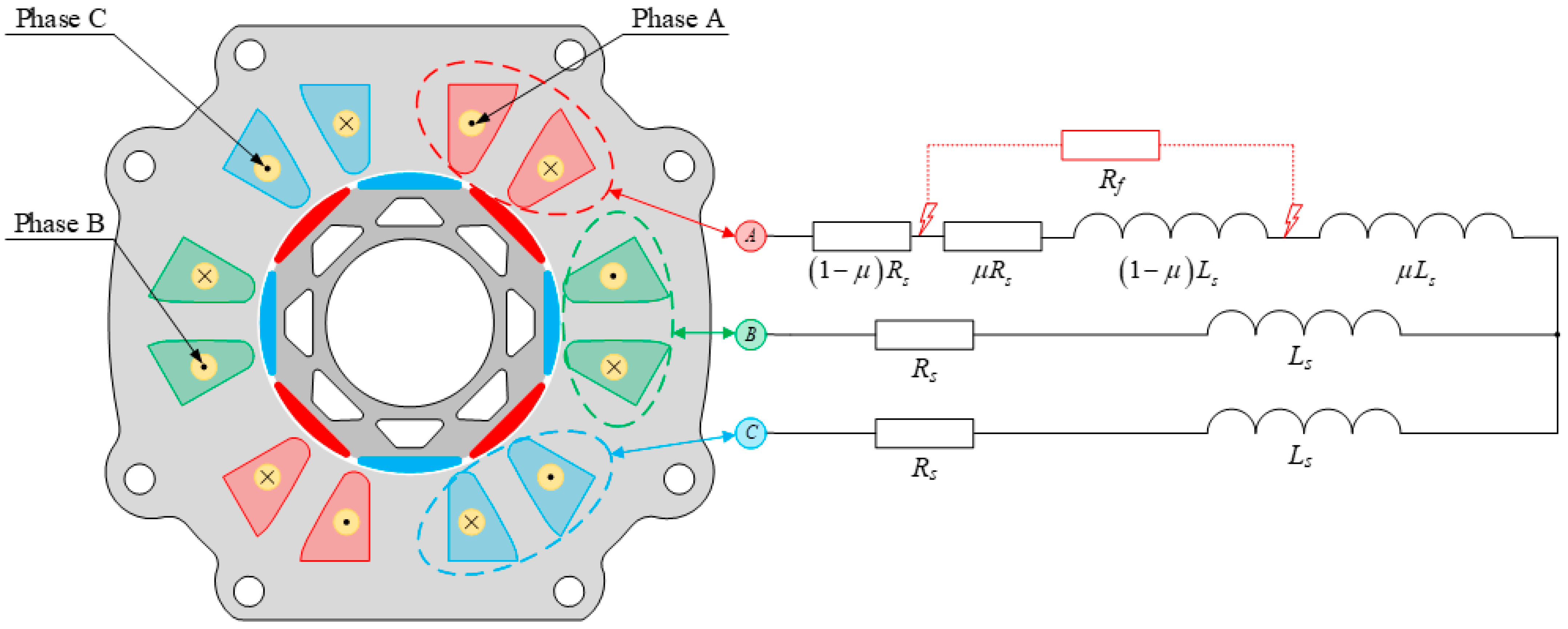


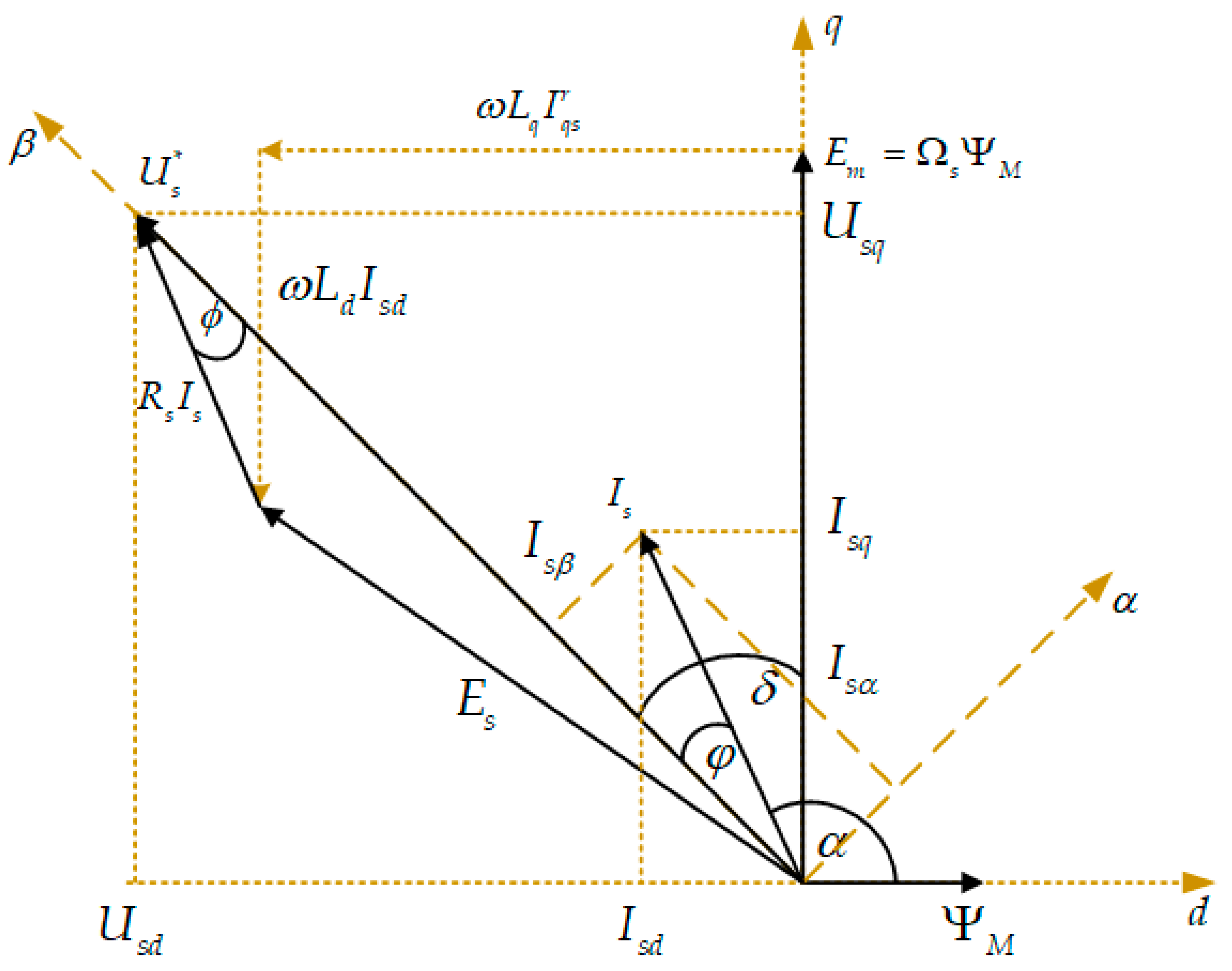

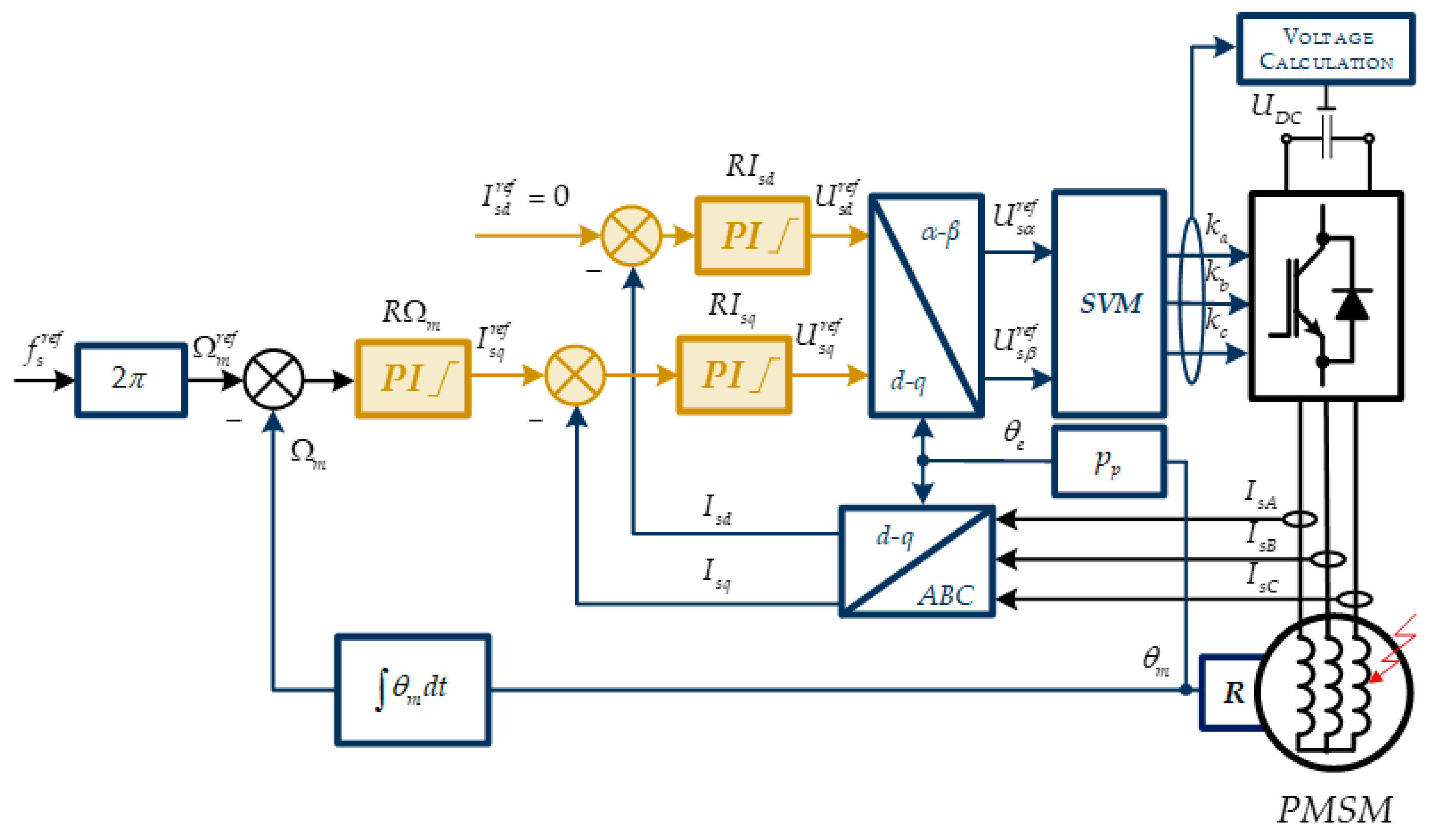

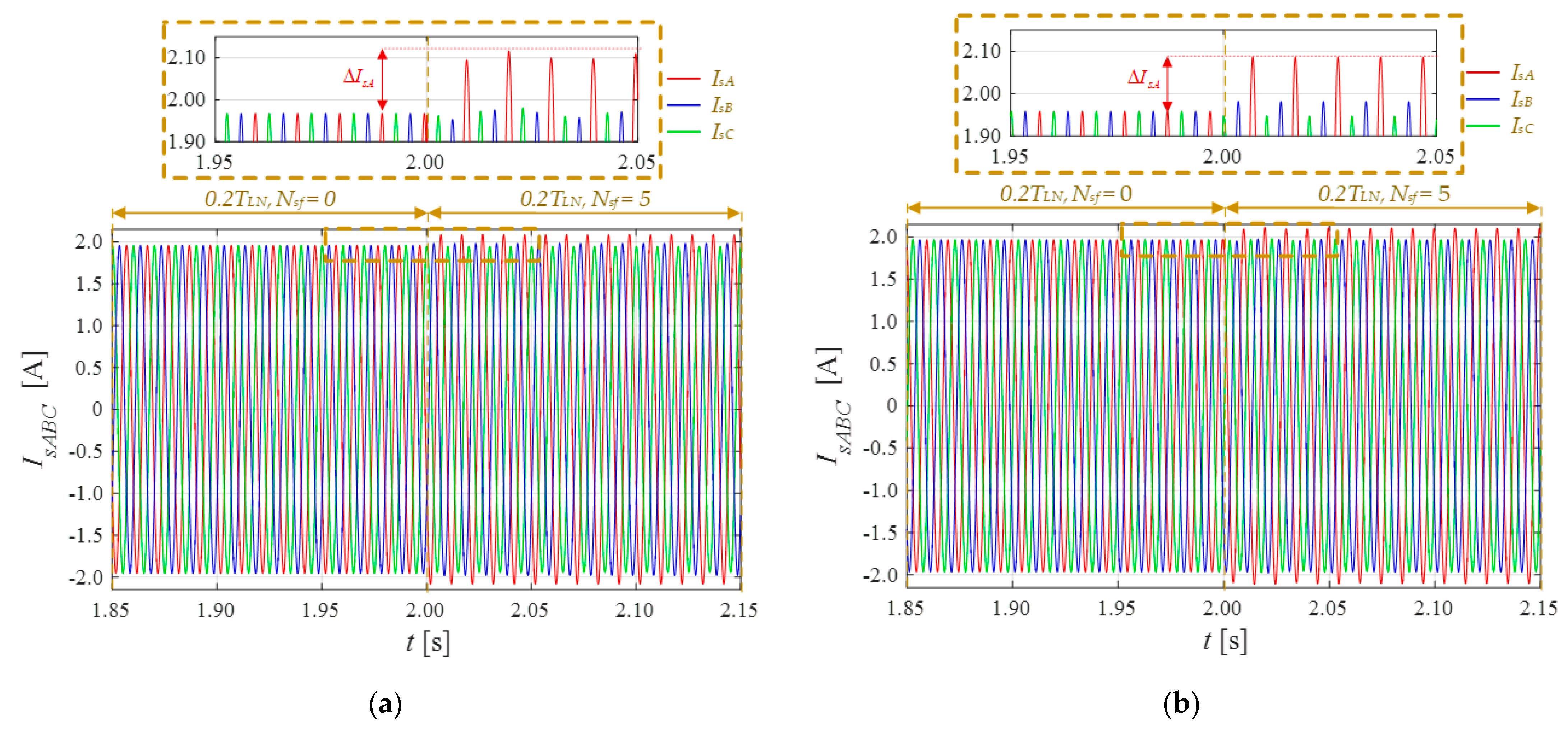


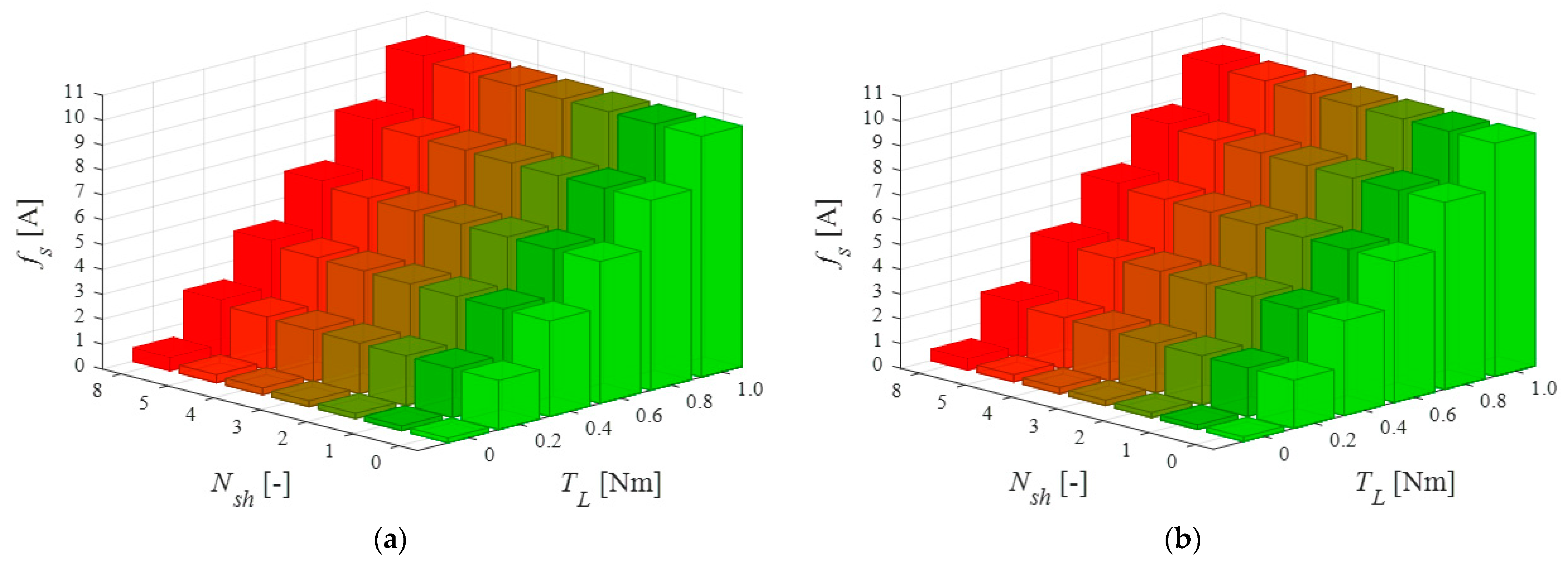
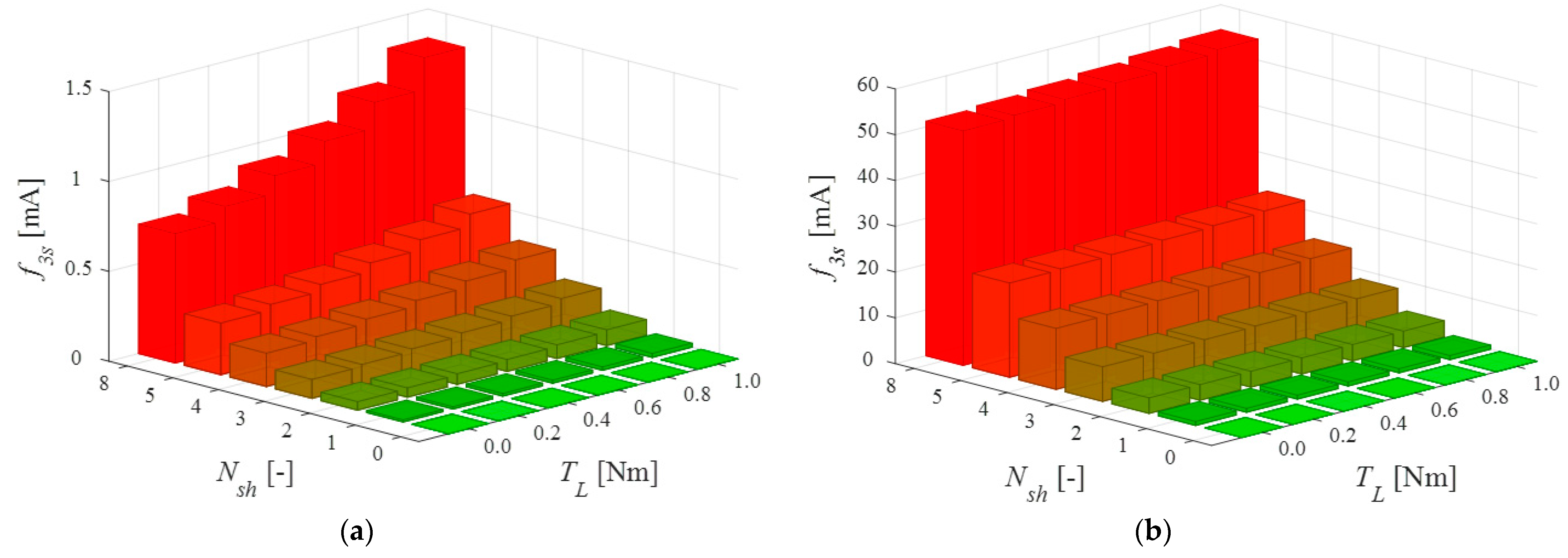
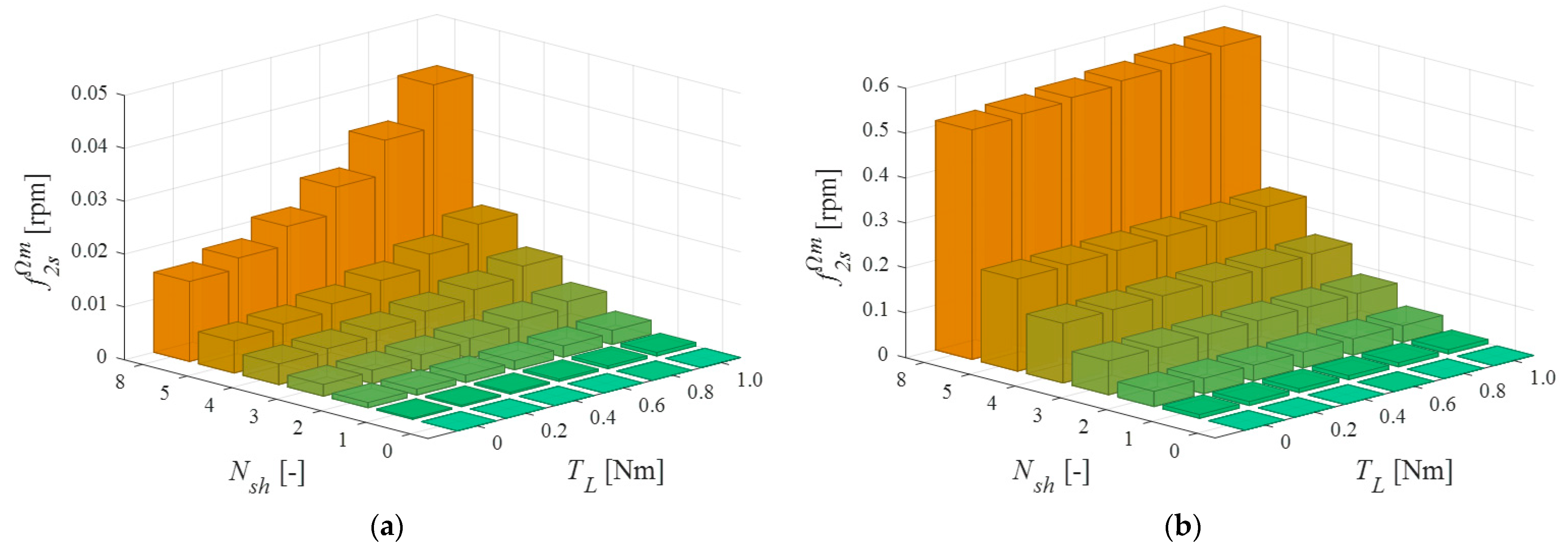
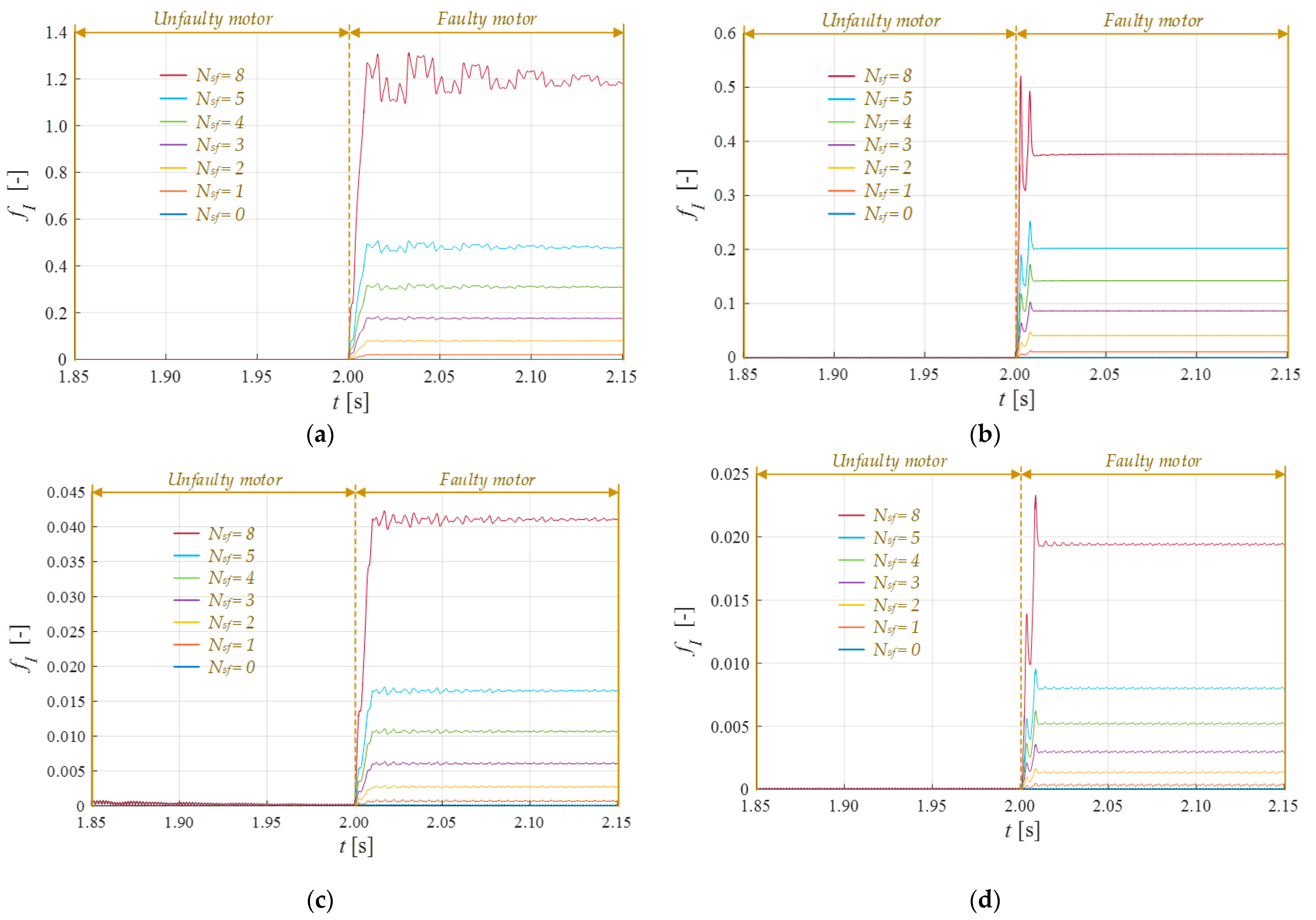
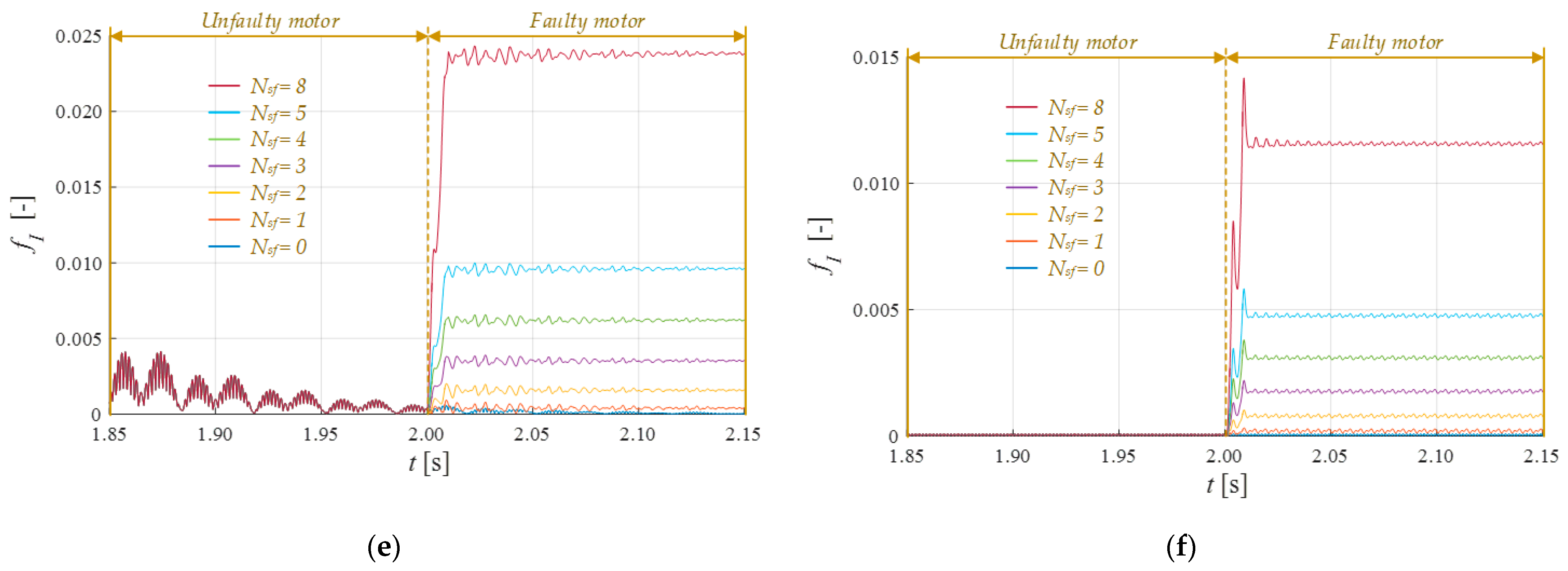
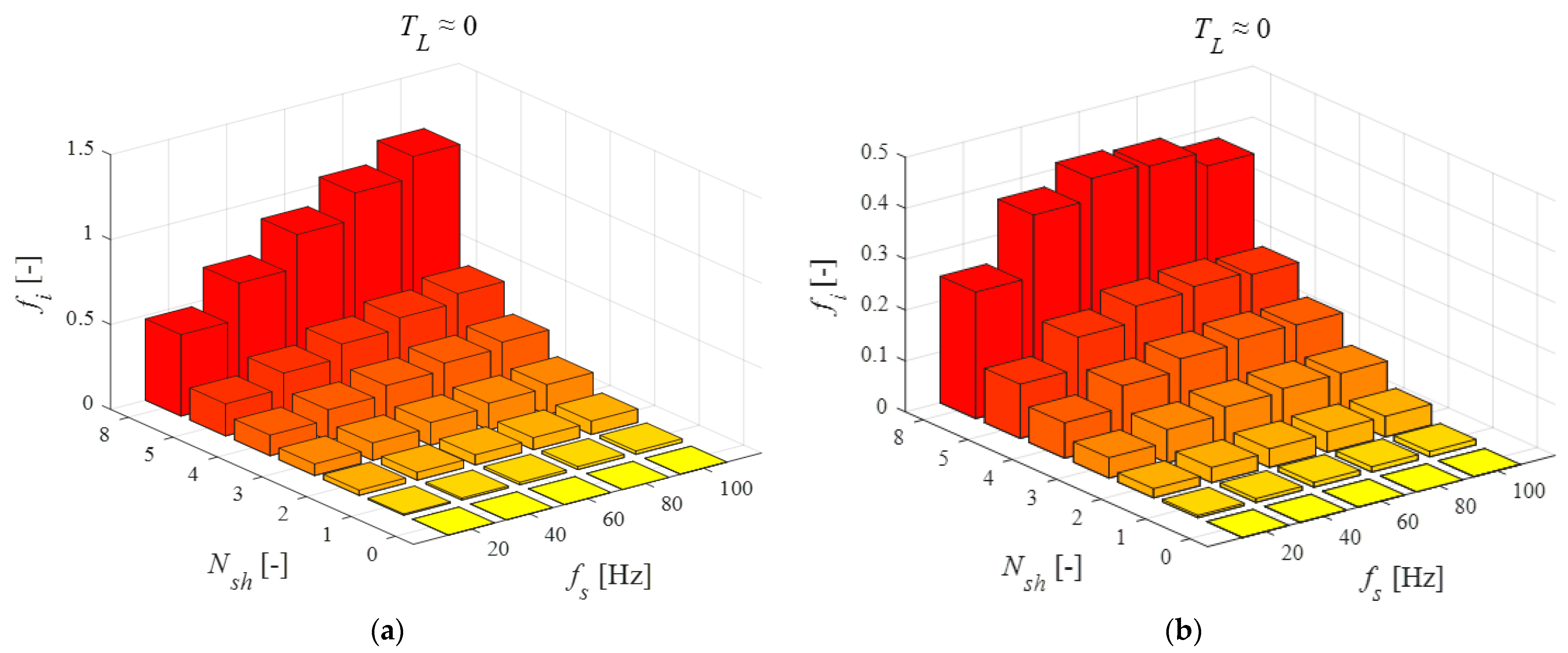

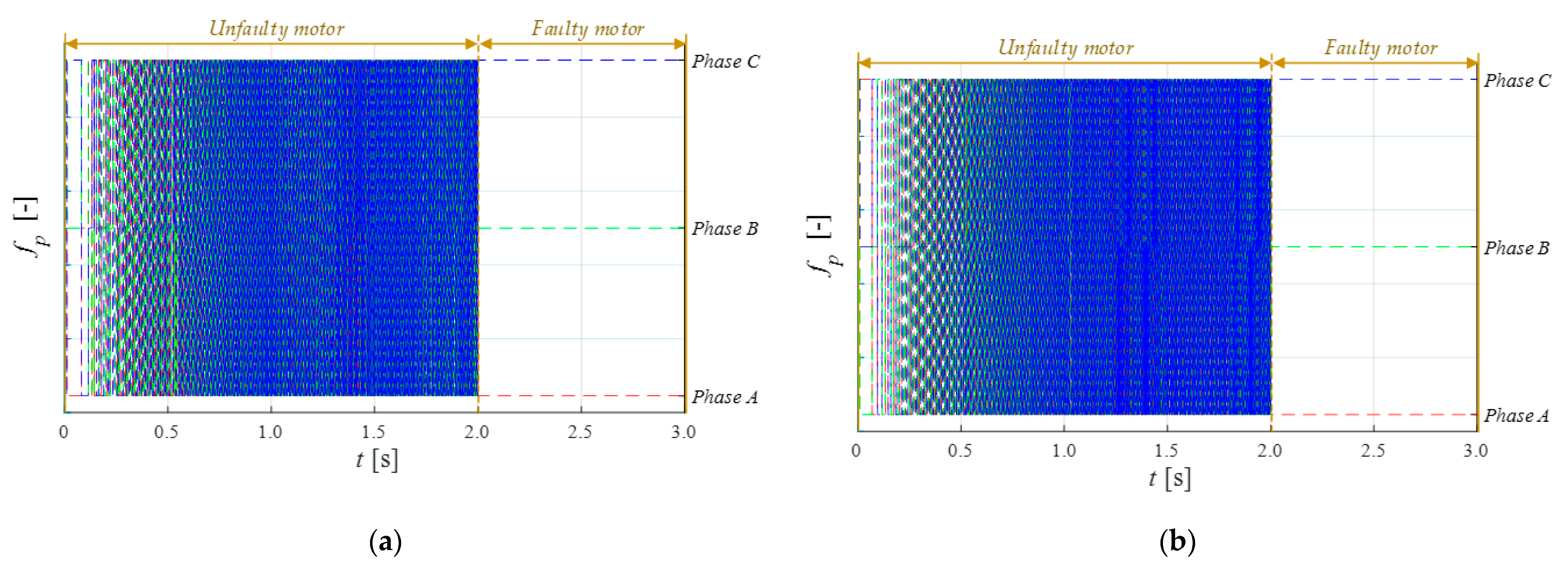
Publisher’s Note: MDPI stays neutral with regard to jurisdictional claims in published maps and institutional affiliations. |
© 2020 by the authors. Licensee MDPI, Basel, Switzerland. This article is an open access article distributed under the terms and conditions of the Creative Commons Attribution (CC BY) license (http://creativecommons.org/licenses/by/4.0/).
Share and Cite
Krzysztofiak, M.; Skowron, M.; Orlowska-Kowalska, T. Analysis of the Impact of Stator Inter-Turn Short Circuits on PMSM Drive with Scalar and Vector Control. Energies 2021, 14, 153. https://doi.org/10.3390/en14010153
Krzysztofiak M, Skowron M, Orlowska-Kowalska T. Analysis of the Impact of Stator Inter-Turn Short Circuits on PMSM Drive with Scalar and Vector Control. Energies. 2021; 14(1):153. https://doi.org/10.3390/en14010153
Chicago/Turabian StyleKrzysztofiak, Mateusz, Maciej Skowron, and Teresa Orlowska-Kowalska. 2021. "Analysis of the Impact of Stator Inter-Turn Short Circuits on PMSM Drive with Scalar and Vector Control" Energies 14, no. 1: 153. https://doi.org/10.3390/en14010153






